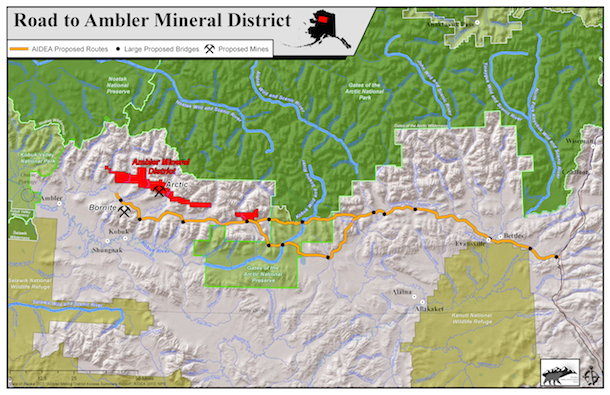The U.S. Bureau of Land Management (BLM) just wrapped up the public comment period for the highly controversial Ambler Road, a proposed 211-mile private industrial mining road across pristine public lands in Alaska’s Southern Brooks Range.
If approved, it would extend across a vast and wild landscape along the Southern Brooks Range, and cut through National Park Service lands in the Gates of the Arctic National Preserve. It would cross 11 major rivers, 3,000 streams, tear through unspoiled tundra and disrupt the migratory path for one of our nation’s most majestic and vital caribou herds.

A Supplemental Draft Environmental Impact Statement, released by the BLM in November 2023, identified extensive and devastating impacts to Alaska rural communities, and vital subsistence resources, including caribou, salmon and sheefish.
The Biden administration is poised to make a decision on the proposed road in 2024. Here are the eight reasons to reject it:
1. It will significantly harm Alaska communities. BLM says the proposed road will impact as many as 66 communities, and finds that any of the road options may significantly restrict subsistence uses in nearly half of them. In other words, the proposed road will jeopardize food security for communities that rely on the region’s intact ecosystems and robust fish and wildlife populations for a thriving, sustainable subsistence lifestyle.
2. It does not enhance U.S. mineral independence. Although the road proponents have repeatedly touted the Ambler Road as necessary to access an “abundance” of critical minerals, the latest mineral resource reports associated with the major mineral deposits in the Ambler District tell a different story. All four major mineral deposits in the Ambler District (Arctic, Bornite, Sun and Smucker) are still undergoing exploration, and no company has submitted an application to mine. Claims of critical minerals are highly uncertain. Even if the Arctic deposit were permitted for development, the company’s feasibility report plans for the ore to be shipped out of the U.S. to be sold for refining in Asia, rather than processing the ore in the U.S. for domestic use.
3. It’s a financial boondoggle. The road is proposed by the Alaska Industrial Development and Export Authority (AIDEA), on behalf of primarily foreign-owned mining companies,[1] at an estimated total cost of roughly $2 billion. AIDEA plans for the mining companies to reimburse the State of Alaska for those costs via a toll system for the road. Its assumption that it will break even in 30 years requires four major mines to be built in the Ambler District. However, there are no actual contracts in place, and none of the mining companies have submitted plans for mining operations – only exploration. This is particularly risky speculation. Two of the four mineral deposits (Sun and Smucker) are in the earliest stages of exploration and a long way from determining whether they will be economic to develop, particularly with the added cost of the road (see recent analysis).
4. It’s widely opposed. There is widespread opposition from regional tribes, including resolutions in opposition from 74 tribes and First Nations in the Yukon River watershed, 37 member tribes of the Tanana Chiefs Conference of interior Alaska, and individual resolutions by tribes nearest to the proposed road: Evansville Tribal Council, Tanana Tribal Council, Alatna Village Council, Allakaket Village Council, and Huslia Tribal Council. It is also opposed by hunters and anglers, and local, state and national conservation organizations.
5. It conflicts with climate goals. Alaska is globally significant for its large tracts of intact habitat and its role in conserving biodiversity and storing carbon while supporting traditional and cultural uses. The construction of a private industrial haul road through these critical wildlands conflicts with our nation’s climate change goals.
6. It’s bad for fish and those that depend on them. The rivers and streams along the Brooks Range are an important source of salmon, which contribute to Alaska’s economy and are vital to local communities. These rivers also provide essential habitat and spawning grounds for sheefish, a giant member of the whitefish family and an essential food source for local communities. BLM determined that cumulatively, the project “has the potential to cause substantial, long-term impacts to fish and aquatic life that could lead to substantial impacts on subsistence use practices in the region, even with mitigation measures in place.”
7. It will disrupt one of the greatest caribou herds left on Earth. The road would fragment habitat and disrupt the migration patterns for 164,000 caribou in the Western Arctic Caribou Herd, one of our nation’s largest and most iconic caribou herds. This herd, which has already declined substantially in recent years, relies on vast tracts of undisturbed lands for its 2,000-mile annual migration, one of the longest land migrations on Earth. BLM found that the impacts from a potential road “could exacerbate or prolong population declines and hinder the herd’s ability to naturally recover from low population levels.”
8. It will harm Gates of the Arctic National Park and Preserve. Lying north of the Arctic Circle, Gates of the Arctic National Park and Preserve is so wild it contains no roads or trails. It is one of the largest protected parkland areas in the world. This vast and wild landscape contains major portions of the range and habitat for the Western Arctic Caribou Herd, and refuge for moose, Dall Sheep, wolverines, and myriad other species. The Ambler Road will cut directly through the National Preserve for 26-miles, damaging this treasured landscape and those that depend on it.
Please join our efforts to protect communities, clean water, and wildlife against the proposed Ambler Road. Sign our petition here, and we will keep you informed about the latest developments.
